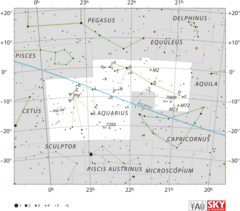Astronomy:Iota Aquarii
| Observation data Equinox J2000.0]] (ICRS) | |
|---|---|
| Constellation | Aquarius |
| Right ascension | 22h 06m 26.22742s[1] |
| Declination | –13° 52′ 10.8615″[1] |
| Apparent magnitude (V) | 4.279[2] |
| Characteristics | |
| Spectral type | B8 V[3] |
| U−B color index | –0.288[2] |
| B−V color index | –0.062[2] |
| Variable type | constant[4] |
| Astrometry | |
| Radial velocity (Rv) | –10.0[5] km/s |
| Proper motion (μ) | RA: +36.89[1] mas/yr Dec.: –58.99[1] mas/yr |
| Parallax (π) | 18.62 ± 0.22[1] mas |
| Distance | 175 ± 2 ly (53.7 ± 0.6 pc) |
| Absolute magnitude (MV) | +0.64[6] |
| Details[7] | |
| A | |
| Mass | 3.20+0.20 −0.16 M☉ |
| Radius | 2.7[8] R☉ |
| Luminosity | 74[6] L☉ |
| Surface gravity (log g) | 4.09±0.08[9] cgs |
| Temperature | 11,284±284[8] K |
| Metallicity [Fe/H] | −0.08±0.12[9] dex |
| Rotational velocity (v sin i) | 135[10] km/s |
| Age | 124+37 −62 Myr |
| B | |
| Mass | 1.00±0.03 M☉ |
| Temperature | 5,710±112 K |
| Rotational velocity (v sin i) | 20 km/s |
| Other designations | |
| Database references | |
| SIMBAD | data |
Iota Aquarii, Latinised from ι Aquarii, is the Bayer designation for a binary star[7] system in the equatorial constellation of Aquarius. It is visible to the naked eye with an apparent magnitude of +4.279.[2] Based upon parallax measurements made during the Hipparcos mission, the distance to this star is around 175 light-years (54 parsecs).[2] The system is drifting closer to the Sun with a radial velocity of −10 km/s.[5]
The binary nature of this system was reported in 2009 following a radial velocity survey using the HARPS instrument.[4] A 2010 infrared search for companions around this star was unsuccessful.[12] The presence of a stellar companion was confirmed through direct spectral detection in 2016. The companion shows a significant velocity variation over a 77-day interval, suggesting a short orbital period.[7]
The spectrum of the primary, component A, fits a stellar classification of B8 V,[3] showing that this is a B-type main-sequence star. It is roughly 124[7] million years old and is spinning rapidly with a projected rotational velocity of 135 km/s.[10] The star has 3.2[7] times the mass of the Sun and 2.7[8] times the Sun's radius. It is radiating 74[6] times the luminosity of the Sun from its photosphere at an effective temperature of ~11,284 km/s.[8] The secondary, component B, has a spectrum of a solar-mass star.[7] The system is a source for X-ray emission.[13]
References
- ↑ 1.0 1.1 1.2 1.3 1.4 van Leeuwen, F. (November 2007), "Validation of the new Hipparcos reduction", Astronomy and Astrophysics 474 (2): 653–664, doi:10.1051/0004-6361:20078357, Bibcode: 2007A&A...474..653V.
- ↑ 2.0 2.1 2.2 2.3 2.4 Kozok, J. R. (September 1985), "Photometric observations of emission B-stars in the southern Milky Way", Astronomy and Astrophysics Supplement Series 61: 387–405, Bibcode: 1985A&AS...61..387K.
- ↑ 3.0 3.1 Houk, Nancy (1978), Michigan catalogue of two-dimensional spectral types for the HD stars, 4, Ann Arbor: Dept. of Astronomy, University of Michigan, Bibcode: 1988mcts.book.....H.
- ↑ 4.0 4.1 Lagrange, A. -M. et al. (2009), "Extrasolar planets and brown dwarfs around A-F type stars. VI. High precision RV survey of early type dwarfs with HARPS", Astronomy & Astrophysics 495 (1): 335–352, doi:10.1051/0004-6361:200810105, Bibcode: 2009A&A...495..335L.
- ↑ 5.0 5.1 Wielen, R. et al. (1999), "Sixth Catalogue of Fundamental Stars (FK6). Part I. Basic fundamental stars with direct solutions", Veroeffentlichungen des Astronomischen Rechen-Instituts Heidelberg (Astronomisches Rechen-Institut Heidelberg) 35 (35): 1, Bibcode: 1999VeARI..35....1W.
- ↑ 6.0 6.1 6.2 Anderson, E.; Francis, Ch. (2012), "XHIP: An extended hipparcos compilation", Astronomy Letters 38 (5): 331, doi:10.1134/S1063773712050015, Bibcode: 2012AstL...38..331A.
- ↑ 7.0 7.1 7.2 7.3 7.4 7.5 Gullikson, Kevin et al. (August 2016), "The Close Companion Mass-ratio Distribution of Intermediate-mass Stars", The Astronomical Journal 152 (2): 13, doi:10.3847/0004-6256/152/2/40, 40, Bibcode: 2016AJ....152...40G.
Note: the observations were made on modified Julian dates 6447.91 and 6524.67, which are separated by 76.76 days. - ↑ 8.0 8.1 8.2 8.3 Underhill, A. B. et al. (November 1979), "Effective temperatures, angular diameters, distances and linear radii for 160 O and B stars", Monthly Notices of the Royal Astronomical Society 189 (3): 601–605, doi:10.1093/mnras/189.3.601, Bibcode: 1979MNRAS.189..601U.
- ↑ 9.0 9.1 Wu, Yue et al. (January 2011), "Coudé-feed stellar spectral library - atmospheric parameters", Astronomy and Astrophysics 525: A71, doi:10.1051/0004-6361/201015014, Bibcode: 2011A&A...525A..71W.
- ↑ 10.0 10.1 Abt, Helmut A.; Levato, Hugo; Grosso, Monica (July 2002), "Rotational Velocities of B Stars", The Astrophysical Journal 573 (1): 359–365, doi:10.1086/340590, Bibcode: 2002ApJ...573..359A.
- ↑ "* iot Aqr". SIMBAD. Centre de données astronomiques de Strasbourg. http://simbad.u-strasbg.fr/simbad/sim-basic?Ident=%2A+iot+Aqr.
- ↑ Ehrenreich, D. et al. (November 2010), "Deep infrared imaging of close companions to austral A- and F-type stars", Astronomy and Astrophysics 523: A73, doi:10.1051/0004-6361/201014763, Bibcode: 2010A&A...523A..73E.
- ↑ Haakonsen, Christian Bernt; Rutledge, Robert E. (September 2009), "XID II: Statistical Cross-Association of ROSAT Bright Source Catalog X-ray Sources with 2MASS Point Source Catalog Near-Infrared Sources", The Astrophysical Journal Supplement 184 (1): 138–151, doi:10.1088/0067-0049/184/1/138, Bibcode: 2009ApJS..184..138H.
External links
 |


